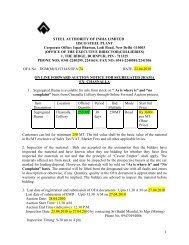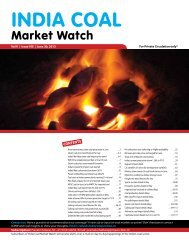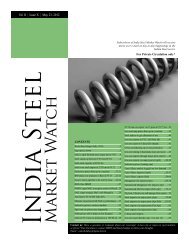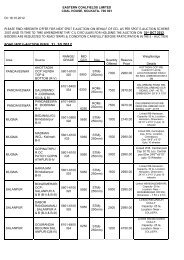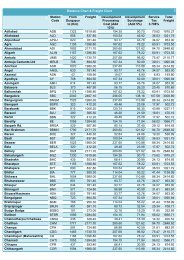India's largest coal handling agency - Mjunction
India's largest coal handling agency - Mjunction
India's largest coal handling agency - Mjunction
Create successful ePaper yourself
Turn your PDF publications into a flip-book with our unique Google optimized e-Paper software.
Expert Speak<br />
Heat recovery chinese coke ovens:<br />
Problems & solutions<br />
Abhijit Sen<br />
Heat Recovery Chinese Coke Ovens made headway in<br />
Indian Steel plants with M/s Jaiswal Neco going for<br />
the first two Chinese bee-hive batteries with stamp<br />
charging facilities. The contract was with Beijing Sino-Steel<br />
Industry and Trade Group Corporation (SSIT), China and the<br />
technology provider was SPCDI (Shanxi Provincial Chemical<br />
Design Institute). Subsequently, VISA Steel, JSPL, BPSL, and<br />
Hooghly Met coke have all opted for the Heat Recovery Ovens<br />
of Chinese design of SPCDI-SSIT combination in various<br />
capacities.<br />
The BPSL Jharsuguda coke oven plant is one of the best<br />
operating plants among all these Chinese plants with almost<br />
100 percent production load consistently, since inception.<br />
However, certain problems did occur notwithstanding its<br />
excellent performance. Moreover, it was observed that some<br />
of the problems were common to almost all the Chinese plants<br />
supplied by SSIT. One such problem was of the damage of<br />
bridge pipes which connect the battery to the branch headers<br />
carrying gas to the chimney.<br />
Basically all these ovens are large bee-hive ovens which<br />
carbonise coking <strong>coal</strong> in partial presence of air near the top<br />
layer of the <strong>coal</strong> cake. Since the charging system belongs to<br />
the stamping category, a large <strong>coal</strong> cake weighing about 47.00<br />
MT is introduced through the ram side door opening. The VM<br />
released from the <strong>coal</strong> first burns in the space above the <strong>coal</strong><br />
cake and the concave roof of the oven arch acts as a concave<br />
mirror reflecting the radiations from the fire ball in the oven<br />
top space. Since the oven operates under chimney suction, the<br />
flue gas after combustion is drawn through the four linked<br />
arches below the sole, the vertical uptakes, the bridge pipes,<br />
the branch headers and the main headers leading to the<br />
chimney. Theoretically speaking, the temperature of the oven<br />
top arch region should be 1200°C to 1250°C and that at the sole<br />
flue should be about 1300°C to 1350°C.<br />
The fire in the oven is to be controlled in such a way that the<br />
entire combustion of the evolved volatile matter burns out in<br />
the oven and the sole flue. No un-burnt coke oven gas should<br />
escape the sole flue. In the uptake region, the temperature of<br />
the flue gas should be below 1100°C and in the bridge pipe<br />
also the temperature should be below 1100°C.<br />
The Refractory<br />
The typical refractory constitution of the oven arch, the oven<br />
sole, the sole flue and the oven walls are all made of silica<br />
bricks which are well suited to bear temperatures up to<br />
1450°C. The bridge pipes are metal fabrications lined with<br />
ceramic fibre board and ceramic fibre castable, which can<br />
stand temperatures up to 1250°C. These bridge pipes connect<br />
the battery to the branch headers, which are lined with folded<br />
modules of ceramic fibre blanket.<br />
The specified temperature in the branch header is about<br />
1000°C and the refractory installed is also suitable to withstand<br />
this temperature. In the Chinese design, the door linings were<br />
also made of ceramic fibre board and ceramic fibre castable.<br />
The use of ceramic fibre in designing the door, bridge pipe and<br />
headers was mainly recommended to reduce the weight of the<br />
refractory lining in these areas.<br />
A brief history of damages<br />
Replacement of a branch header segment is in progress in COP<br />
1) Upper Oven Doors<br />
The damages to the upper oven door started with a small<br />
defect in the implementation work of the lining during the<br />
project stage itself. It comprised the wrong erection of one row<br />
of L-shaped bricks at the bottom of the upper door. Although<br />
the entire linings of upper and lower doors were executed<br />
under close supervision of Chinese experts, this small item<br />
was overlooked. The problem was detected when all doors<br />
were erected, the plant commissioned and was subsequently<br />
taken on range for full load operation.<br />
Although the first upper door replacement was done in<br />
August 2008, the damage actually had started much earlier,<br />
along with the lower oven doors. Due to faulty erection, the<br />
COAL INSIGHTS 55 October 2010



